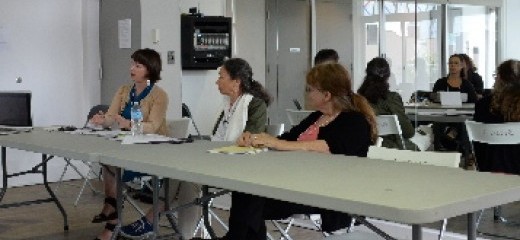
Photo: Robert Abrams
Is North American Dance In Crisis?
by Annie Wilson
Yes, yes it is, we say. As dance artists, critics, scholars, professors and enthusiasts, we wring our hands at the dying art form. We ask each other why? Sometimes we fly across the country to gather in well air-conditioned rooms. We sit in plastic chairs behind a plastic table. We speak with a video camera recording us, and a microphone on our lapels, and ask why? Why does no one pay attention to dance or dance writing? At the 2013 Dance Critics Association (DCA) Conference, in collaboration with the World Dance Alliance-Americas (WDA-A) Conference held at the Scotiabank Dance Centre in downtown Vancouver, the question why produced its own questions: Why are we so fixated on preserving an established approach to criticism that we become suspicious of innovation? Is there room for both?
The 2013 DCA conference was titled “Redefining the Field: Shifts in Critical Perception and Dance Writing.” My attendance was made possible in part through a Gary Parks Memorial Scholarship, given by DCA. The rest of the trip was made possible through an Indiegogo campaign, a testament to the enthusiasm my community has for dance and its criticism.
I attended many panels on a variety of subjects. One addressed the role of the critic-as-educator when so many dance organizations make educational outreach part of their mission. Another asked, “Who are dance critics today?” and reminisced about the glory days when critics had full-time jobs and benefits. Vancouver critics spoke about the city’s dance and criticism scene. Participants workshopped each other’s writing for hours. Professors from various colleges in the Pacific Northwest discussed how the increased emphasis on writing in undergraduate dance programs is shifting the paradigm that dancers’ sole intelligence is kinesthetic. The most energizing part of the conference was the panel on branding in the digital world, which led to a much-needed discussion about the role of the digital world in dance’s future. Throughout the weekend conference participants spoke articulately and intelligently, revealing their wealth of knowledge of dance and its history. Feedback on writing was generous. I met and befriended writers, artists, and educators who care deeply about the field. Despite this, I felt that the vitality, the quickening, was missing.
Dance criticism lurches reluctantly into the twenty-first century. There is tension between the principles that guide pre-Internet criticism and those that guide writing for the web. In “Spotlight on Vancouver,” Alex Ferguson bemoaned the lack of editing in online publications, which means most dance criticism published digitally is little more than glorified blogging. In the panel “Who Are Dance Critics Today?” veteran critic Carolyn Keleman asked Mariko Nagashima, a young writer and director of the online publication SeattleDances, what she was doing to continue to educate herself about dance. Keleman holds a master’s degree from Mills College that she earned for the purpose of writing criticism authoritatively. I wondered if older critics are suspicious of how younger critics are honing their craft. Sandra Kurtz noted that the trend toward a casual tone has made writing sloppy. We all agreed that the Internet is an overwhelming rabbit hole of information, so finding current criticism that can provide historical context and nuanced analysis is difficult. I absolutely agree that these are important issues, but solutions were few. Consider this along with the fact that the feedback I received on my writing included the instruction neither to use the word “I” nor to include the audience experience in a review. This was surprising. Audience experience is an increasingly important part of the twenty-first century performance object, and subjective criticism is becoming, more and more, a valid way to write as it mimics the new Internet language. I began to suspect that the goal of the conference was less to address the contemporary challenges at hand than to reaffirm the old school of criticism.
That is, until we reached the final panel, on “branding.” Speakers included Tonya Lockyer, Artistic Director of
Velocity Dance Center. One question she constantly asks of the Seattle dance hub is: “How do we make what we do more relevant? What values are we creating?” Right! Dance and dance writing don’t belong cloistered away, like a fragile virgin nun. They need to function in the world, which includes, for better or worse, the Internet. Panelist Max Wyman, a Vancouver-based critic and one of Canada’s leading cultural commentators, advised, “If you can’t get your message across in 140 characters, you’re not doing it right.” He also noted, “TV draws people by the million to watch dance. Why can’t we?” Why can’t we, indeed? How can we pull what we learned about criticism in the past century into the format of the next?
Maybe a good conference is like a good dance: it leaves you with more questions than answers. I don’t know what the answers are. But maybe I, and other attendees, can use these questions to envision a twenty-first century dance criticism, one that serves the field, and the world. One that acknowledges where we came from and looks ahead to where we are going.
Dance Critics Association Conference. Scotiabank Dance Centre, Vancouver, BC, Canada. August 2-4, 2013. Two other reflections on this conference are published on thinkingdance.net: “
Alliance: That Which Unites Us,” by Becca Weber and “
Dancers Confer, by Lynn Matluck Brooks
By Annie Wilson
September 8, 2013

